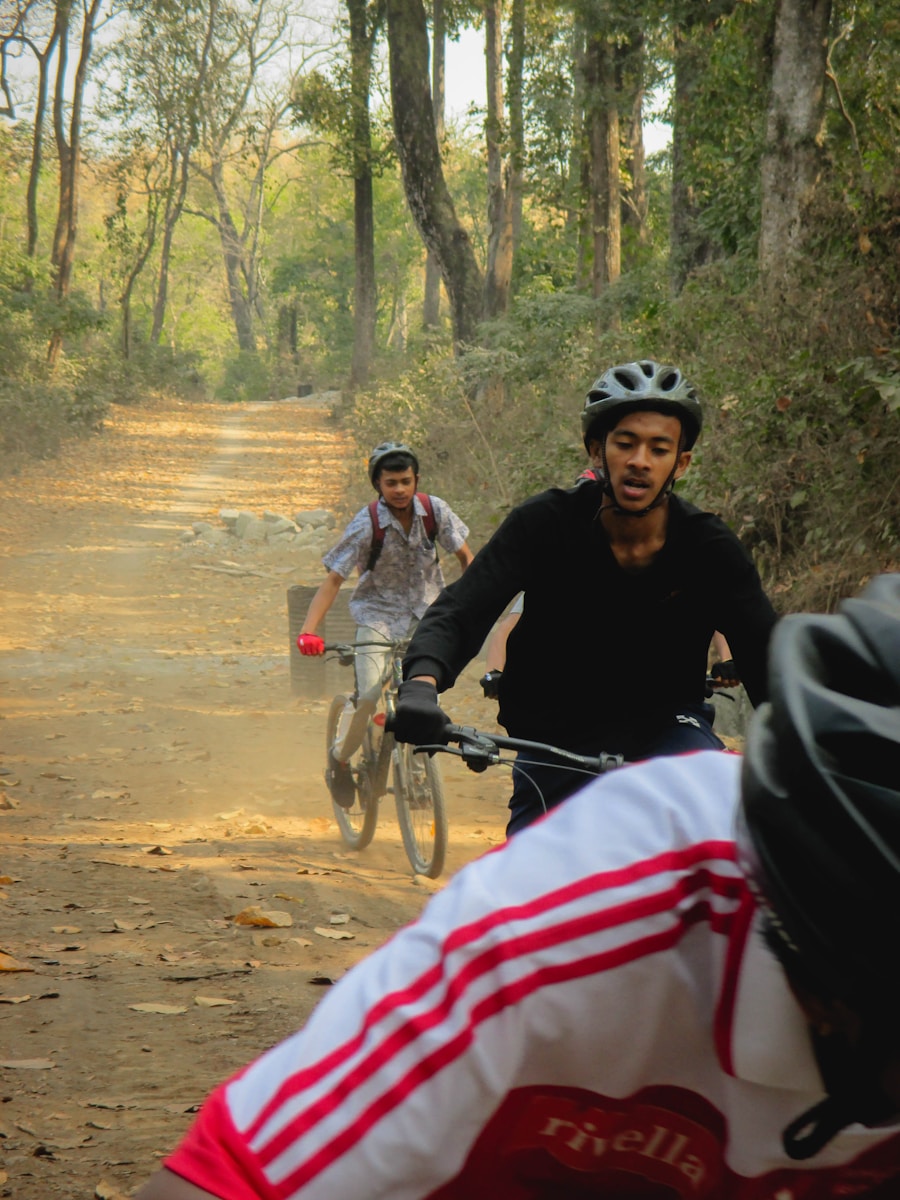As we roll into 2025, the gravel cycling world is experiencing a seismic shift. The lines between gravel bikes and mountain bikes are blurring faster than ever, with manufacturers pushing the boundaries of what we consider a “gravel” bike. Today, we’re diving deep into five cutting-edge machines that can officially accommodate 2.2-inch (56mm) or wider MTB tires—and what this means for the future of cycling.
Why Go Wide? The Revolution in Tire Clearance
The push toward wider tires isn’t just about following trends—it’s about fundamentally reimagining what gravel bikes can do. Here’s what’s driving this revolution:
- ✓ Enhanced Comfort: Wider tires run at lower pressures, smoothing out rough terrain like nature’s own suspension system
- ✓ Increased Speed on Rough Terrain: Counter-intuitively, wider tires can be faster on chunky gravel and technical trails
- ✓ Technical Trail Capability: Access terrain previously reserved for mountain bikes
- ✓ Adventure Versatility: One bike to rule them all—from smooth gravel to singletrack
Most gravel-specific tires max out at 50mm, so stepping up to 56mm+ means entering MTB tire territory—opening up a whole new world of rubber options and riding possibilities.
The Magnificent Five: Bikes Leading the Wide-Tire Revolution
1. Lauf Seigla: The Icelandic Pioneer
Tire Clearance: 57mm (2.25″)
Key Innovation: Achieves massive clearance without elevated or dropped chainstays
Rear End Length: 425mm (impressively short and nimble)
The Lauf Seigla represents the evolution of Icelandic ingenuity. Built to conquer the brutal Rift gravel race across Iceland’s volcanic terrain, this bike doesn’t compromise. What’s remarkable is how Lauf achieves this clearance while maintaining traditional chainstay positioning—a feat of engineering that keeps the bike’s handling sharp and responsive.
“The Lauf True Grit pioneered wide tire clearance back in 2017 with then-revolutionary 45mm clearance. The Seigla takes this philosophy to its logical extreme.”
2. Allied Able (2025 Update): American Racing Pedigree
Tire Clearance: 57mm
Key Feature: Dropped stays for tire clearance with integrated hose routing
Racing Heritage: Proven at major American gravel events
The 2025 Allied Able represents a significant aesthetic and functional evolution. Gone are the unusual raised chainstays of earlier models, replaced by a sleeker dropped-stay design that doesn’t sacrifice performance. This bike has been battle-tested at events like Unbound Gravel, proving that wide tires and racing performance aren’t mutually exclusive.
3. Argon 18 Dark Matter (2025): Canadian Innovation
Tire Clearance: 57mm (2.2″)
Tech Features: UDH compatibility, integrated frame storage
Versatility: Multiple cargo boss mounts for adventure loading
The Dark Matter is Argon 18’s answer to the question: “What if we made one bike that could excel at everything?” From high-stakes racing at Unbound and Traka to multi-day bikepacking adventures, this Canadian creation refuses to be pigeonholed. The integrated storage and mounting options make it as practical as it is fast.
4. Salsa Cutthroat: The Adventure Maximizer
Tire Clearance: 2.4″ (actual MTB tire sizing)
Special Feature: MTB boost spacing (148mm rear)
Purpose: Ultra-endurance and Tour Divide racing
The Cutthroat isn’t trying to be a gravel bike that can handle MTB tires—it’s an adventure machine that happens to have drop bars. With clearance for legitimate 2.4″ mountain bike rubber and boost spacing, this is the bike for riders who measure their adventures in days, not hours.
🏆 Historical Note: Salsa created the first true gravel-specific bike with the Warbird in 2013, cementing their place as pioneers in the category.
5. Drop-Bar Mountain Bikes: The Wild Card
Perhaps the most intriguing trend is the rise of drop-bar conversions on mountain bikes. Keegan Swenson’s Leadville 100 victory on a drop-bar-equipped Santa Cruz Highball hardtail MTB sent shockwaves through the cycling world. This isn’t just a fringe experiment anymore—it’s a legitimate racing strategy that’s blurring category lines beyond recognition.
The Big Question: Where Does Gravel End and Mountain Begin?
As these bikes push the boundaries of tire clearance and capability, we’re forced to confront a fundamental question about the identity of gravel cycling. Are we witnessing:
The Evolution Scenario
Gravel bikes naturally evolving to meet rider demands for more capability and comfort?
The Convergence Theory
The inevitable merging of gravel and XC mountain biking into a new super-category?
What This Means for You
Whether you’re a racer, adventure rider, or weekend warrior, these developments open up exciting possibilities:
- One Bike, Many Adventures: These bikes can handle everything from fast group rides to technical singletrack
- Comfort Without Compromise: Wider tires mean less fatigue on long days without sacrificing speed
- Future-Proofing: As tire technology advances, these bikes are ready for whatever comes next
- Category-Defying Performance: Why choose between a gravel bike and a hardtail when you can have both?
The Bottom Line
The gravel bike market is moving fast toward models capable of running super-wide MTB tires. This isn’t just about following trends—it’s about enabling riders to explore further, ride faster on rough terrain, and enjoy unprecedented versatility. The five bikes highlighted here aren’t just products; they’re signposts pointing toward a future where the only limit is your imagination.
Will gravel bikes ultimately merge with mountain bikes, or do narrower gravel tires still have their place? The debate continues, but one thing is certain: the future of gravel is wide, wild, and wonderfully undefined.




As someone who made the switch from pure MTB to gravel last year, this article really hits home! I went with the Salsa Cutthroat and absolutely love it. The 2.4″ tire clearance means I can still hit all my favorite singletrack, but now I’m also crushing those long gravel epics with my roadie friends. Best of both worlds!
One thing worth mentioning – the wider tires have completely changed my approach to tire pressure. I’m running 28-30 PSI on chunky gravel now, and it’s like having a magic carpet under me. No more getting bounced around!
Sarah, your tire pressure setup sounds spot on! For anyone else making the switch to wider tires, here’s a quick pressure guide I use in the shop:
– 2.0″ tires: 30-35 PSI for mixed terrain
– 2.2″ tires: 28-32 PSI
– 2.4″ tires: 25-30 PSI
Always adjust based on rider weight and terrain, but these are good starting points. And yes, it feels like floating on air compared to the old days of 40+ PSI on narrow tires!
Interesting perspective, but I’m still not sold on the super-wide tire trend. I’ve been racing gravel for 5 years on 42mm tires and doing just fine. The weight penalty and increased rolling resistance on smooth gravel roads just isn’t worth it for me.
That said, I can see the appeal for ultra-endurance stuff or if you’re regularly mixing in technical singletrack. Different tools for different jobs, I suppose!
Great point about different tools for different jobs, Mike! You’re absolutely right that 42mm tires are perfect for many gravel races and fast group rides. The beauty of the current market is that we have options for every riding style.
What’s interesting is that recent studies show wider tires can actually have LOWER rolling resistance on rough surfaces due to reduced suspension losses. But on smooth hardpack? Your 42s will definitely be faster. It’s all about matching the tire to your typical terrain.
From a shop perspective, we’re seeing HUGE demand for these wider-clearance bikes. Customers are tired of having multiple bikes for different purposes. The Argon 18 Dark Matter has been flying off our floor – people love the idea of one bike that can do their Tuesday night group ride AND weekend bikepacking trip.
Pro tip for anyone considering the switch: Start with a 2.0″ tire and see how you like it before going full 2.4″. The handling characteristics do change, and it’s good to ease into it.
The engineering challenges these manufacturers are solving are fascinating! Getting 57mm clearance while keeping the rear end at 425mm (Lauf Seigla) is no joke. Most bikes need to go to 435mm+ chainstays to fit those tires.
What really excites me is the potential for future tire tech. Imagine what we’ll see when tire manufacturers start designing specifically for this 2.0-2.4″ gravel segment instead of just borrowing from MTB. Lower rolling resistance compounds with that volume? Game changer incoming! 🚀